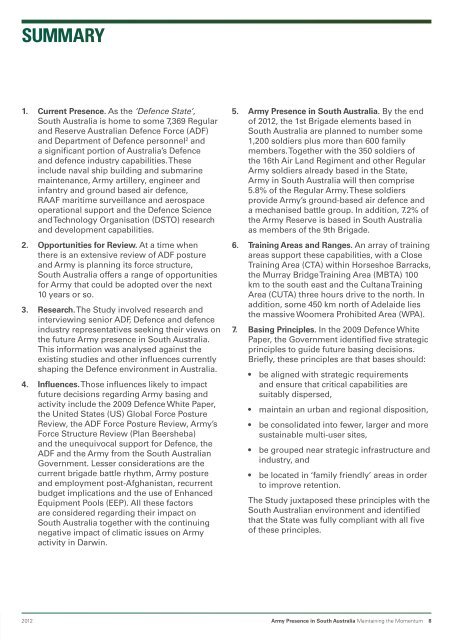ArMy PreSence in South AuStrAliA - Defence SA
ArMy PreSence in South AuStrAliA - Defence SA
ArMy PreSence in South AuStrAliA - Defence SA
You also want an ePaper? Increase the reach of your titles
YUMPU automatically turns print PDFs into web optimized ePapers that Google loves.
SuMMAry<br />
1. Current Presence. As the ‘<strong>Defence</strong> State’,<br />
<strong>South</strong> Australia is home to some 7,369 Regular<br />
and Reserve Australian <strong>Defence</strong> Force (ADF)<br />
and Department of <strong>Defence</strong> personnel 2 and<br />
a significant portion of Australia’s <strong>Defence</strong><br />
and defence <strong>in</strong>dustry capabilities. These<br />
<strong>in</strong>clude naval ship build<strong>in</strong>g and submar<strong>in</strong>e<br />
ma<strong>in</strong>tenance, Army artillery, eng<strong>in</strong>eer and<br />
<strong>in</strong>fantry and ground based air defence,<br />
RAAF maritime surveillance and aerospace<br />
operational support and the <strong>Defence</strong> Science<br />
and Technology Organisation (DSTO) research<br />
and development capabilities.<br />
2. Opportunities for Review. At a time when<br />
there is an extensive review of ADF posture<br />
and Army is plann<strong>in</strong>g its force structure,<br />
<strong>South</strong> Australia offers a range of opportunities<br />
for Army that could be adopted over the next<br />
10 years or so.<br />
3. Research. The Study <strong>in</strong>volved research and<br />
<strong>in</strong>terview<strong>in</strong>g senior ADF, <strong>Defence</strong> and defence<br />
<strong>in</strong>dustry representatives seek<strong>in</strong>g their views on<br />
the future Army presence <strong>in</strong> <strong>South</strong> Australia.<br />
This <strong>in</strong>formation was analysed aga<strong>in</strong>st the<br />
exist<strong>in</strong>g studies and other <strong>in</strong>fluences currently<br />
shap<strong>in</strong>g the <strong>Defence</strong> environment <strong>in</strong> Australia.<br />
4. Influences. Those <strong>in</strong>fluences likely to impact<br />
future decisions regard<strong>in</strong>g Army bas<strong>in</strong>g and<br />
activity <strong>in</strong>clude the 2009 <strong>Defence</strong> White Paper,<br />
the United States (US) Global Force Posture<br />
Review, the ADF Force Posture Review, Army’s<br />
Force Structure Review (Plan Beersheba)<br />
and the unequivocal support for <strong>Defence</strong>, the<br />
ADF and the Army from the <strong>South</strong> Australian<br />
Government. Lesser considerations are the<br />
current brigade battle rhythm, Army posture<br />
and employment post-Afghanistan, recurrent<br />
budget implications and the use of Enhanced<br />
Equipment Pools (EEP). All these factors<br />
are considered regard<strong>in</strong>g their impact on<br />
<strong>South</strong> Australia together with the cont<strong>in</strong>u<strong>in</strong>g<br />
negative impact of climatic issues on Army<br />
activity <strong>in</strong> Darw<strong>in</strong>.<br />
2012<br />
5. Army Presence <strong>in</strong> <strong>South</strong> Australia. By the end<br />
of 2012, the 1st Brigade elements based <strong>in</strong><br />
<strong>South</strong> Australia are planned to number some<br />
1,200 soldiers plus more than 600 family<br />
members. Together with the 350 soldiers of<br />
the 16th Air Land Regiment and other Regular<br />
Army soldiers already based <strong>in</strong> the State,<br />
Army <strong>in</strong> <strong>South</strong> Australia will then comprise<br />
5.8% of the Regular Army. These soldiers<br />
provide Army’s ground-based air defence and<br />
a mechanised battle group. In addition, 7.2% of<br />
the Army Reserve is based <strong>in</strong> <strong>South</strong> Australia<br />
as members of the 9th Brigade.<br />
6. Tra<strong>in</strong><strong>in</strong>g Areas and Ranges. An array of tra<strong>in</strong><strong>in</strong>g<br />
areas support these capabilities, with a Close<br />
Tra<strong>in</strong><strong>in</strong>g Area (CTA) with<strong>in</strong> Horseshoe Barracks,<br />
the Murray Bridge Tra<strong>in</strong><strong>in</strong>g Area (MBTA) 100<br />
km to the south east and the Cultana Tra<strong>in</strong><strong>in</strong>g<br />
Area (CUTA) three hours drive to the north. In<br />
addition, some 450 km north of Adelaide lies<br />
the massive Woomera Prohibited Area (WPA).<br />
7. Bas<strong>in</strong>g Pr<strong>in</strong>ciples. In the 2009 <strong>Defence</strong> White<br />
Paper, the Government identified five strategic<br />
pr<strong>in</strong>ciples to guide future bas<strong>in</strong>g decisions.<br />
Briefly, these pr<strong>in</strong>ciples are that bases should:<br />
• be aligned with strategic requirements<br />
and ensure that critical capabilities are<br />
suitably dispersed,<br />
• ma<strong>in</strong>ta<strong>in</strong> an urban and regional disposition,<br />
• be consolidated <strong>in</strong>to fewer, larger and more<br />
susta<strong>in</strong>able multi-user sites,<br />
• be grouped near strategic <strong>in</strong>frastructure and<br />
<strong>in</strong>dustry, and<br />
• be located <strong>in</strong> ‘family friendly’ areas <strong>in</strong> order<br />
to improve retention.<br />
The Study juxtaposed these pr<strong>in</strong>ciples with the<br />
<strong>South</strong> Australian environment and identified<br />
that the State was fully compliant with all five<br />
of these pr<strong>in</strong>ciples.<br />
Army Presence <strong>in</strong> <strong>South</strong> Australia Ma<strong>in</strong>ta<strong>in</strong><strong>in</strong>g the Momentum 8


